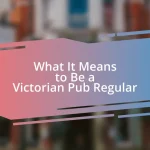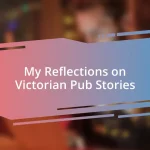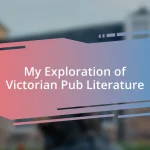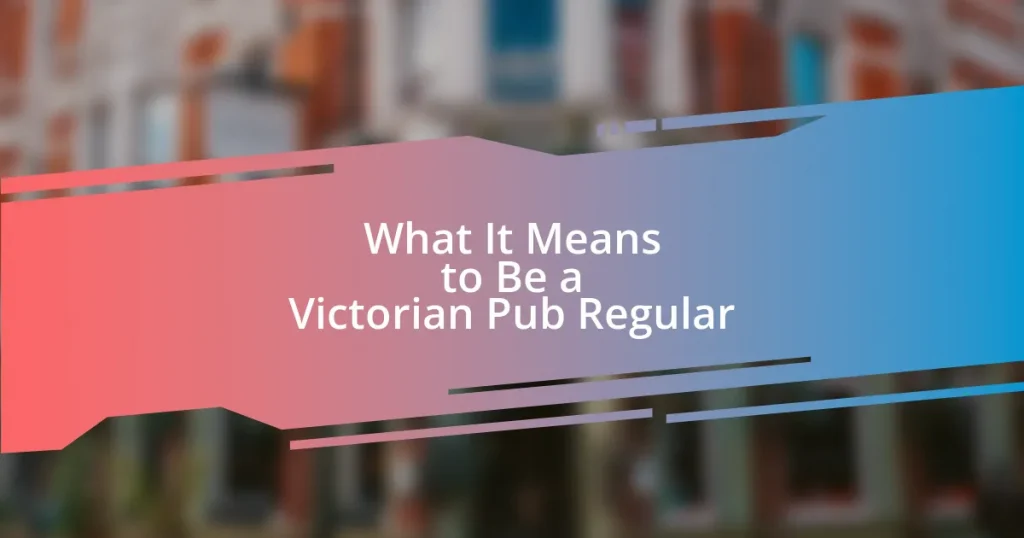Key takeaways:
- Victorian-themed events create immersive experiences through attention to detail in decor, attire, and activities, enhancing the historical ambiance.
- Selecting an appropriate venue is crucial; choose options with architectural charm and atmosphere to complement the Victorian theme.
- Encouraging guests to wear period-appropriate costumes and engaging in traditional activities like tea parties enriches the overall experience.
- Documenting and sharing experiences through photography and storytelling fosters community and preserves memories from themed events.

Victorian-themed event overview
Attending a Victorian-themed event feels like stepping into a living history book. I remember the first time I donned a corset and long skirt, feeling both out of place and part of something grand. Do you ever wonder how our modern lives would change if we embraced the elegance and etiquette of that era?
Victorian-themed events often revolve around rich literary influences, showcasing everything from poetry readings to theatrical performances. One evening, I found myself captivated by a dramatic reading of a classic Dickens novel; the ambiance with flickering gas lamps and the scent of lavender filled the air. It really brought to life the conversational art and social intricacies of the time, didn’t it?
Another fascinating aspect is the attention to detail in the decor. I distinctly recall a gathering where the tables were adorned with lace doilies and vintage china. The colors and textures transported me back to a time when elegance was a way of life. It makes one reflect—what kinds of connections were fostered in that world where social gatherings were such intricate affairs?

Planning your Victorian-themed event
When I first decided to plan a Victorian-themed event, I was both excited and overwhelmed. The key is to create an atmosphere that truly embodies the charm and sophistication of the era. Focus on selecting a specific aspect of Victorian culture that resonates with you—be it literature, fashion, or social customs—as this will guide your planning process.
Here are some essential points to consider for a successful Victorian-themed event:
- Location: Choose a venue that enhances the Victorian ambiance, such as a stately home or an elegant garden.
- Attire: Encourage guests to wear period-appropriate clothing. I once made the mistake of not reminding attendees to dress up, and it really diluted the experience.
- Decor: Opt for rich fabrics, antique furnishings, and dim lighting to evoke the right mood. I love using vintage-inspired centerpieces for a touch of authenticity.
- Activities: Incorporate games or performances typical of the era. At my last event, we enjoyed a lively Charleston-inspired dance class that added a fun twist.
- Refreshments: Serve traditional fare and beverages, like tea and scones. The first time I offered Victorian sweets, it was a delightful way to transport everyone back in time.
Thinking through these details really transcends the mere act of hosting an event; it transforms it into an immersive experience.

Choosing the right venue
Selecting the right venue for your Victorian-themed event can truly set the stage for a memorable experience. From my own escapades, I’ve discovered that marrying the venue’s architectural style with the event’s theme is essential. For instance, opting for a restored Victorian hall not only impressed my guests but also provided a backdrop that transported us straight into the 19th century.
When considering a venue, think about the overall atmosphere and accessibility. Larger spaces with high ceilings often evoke the grandeur of the Victorian era, while intimate settings can create a warm, inviting feel. At one event, we held a tea party in a charming Victorian greenhouse full of blooming flowers, which added a touch of whimsy and magic. It’s these little choices that can enhance the overall mood of the gathering.
Don’t neglect the logistics, such as lighting and acoustics, which play a significant role in creating that authentic Victorian vibe. I vividly remember an artful use of candlelit chandeliers that not only illuminated our space beautifully but also cast enchanting shadows, enriching the atmosphere. Ensuring that your venue aligns perfectly with your vision can make all the difference.
| Venue Type | Pros | Cons |
|---|---|---|
| Historic Mansion | Authentic Victorian architecture | May require higher rental fees |
| Garden Venue | Beautiful natural setting | Weather dependent |
| Community Hall | Affordable and accessible | Less atmospheric charm |
| Private Home | Intimate and personal feel | Space limitations |

Costumes and attire suggestions
When it comes to Victorian costumes, attention to detail is key. I still remember the thrill of piecing together my first Victorian gown; the richness of the fabric and the intricate lace detailing truly made me feel like I’d stepped into the past. Consider inviting your guests to fully embrace the style with corsets, bustles, and vests, as even the smallest elements can transport everyone into the 19th century.
It’s also about creativity when it comes to attire. For instance, I once found myself at a gathering where guests mixed elements from different Victorian fashion subcultures, resulting in a delightful variety of styles, from the upper crust to the bohemian. You might encourage attendees to explore local thrift stores or costume shops to find unique pieces that resonate with their personal style, which not only enhances the event but also sparks conversations about fashion history.
Accessories play a crucial role in completing a Victorian look. Picture top hats adorned with feathers or delicate parasols that glitter in the sunlight—those little touches can make a striking difference. I remember one event where a guest showcased an exquisite Victorian mourning brooch, which not only served as a conversation starter but also added depth to our understanding of the era’s customs. Wouldn’t you agree that these personal stories and unique accessories enrich the collective experience?

Incorporating authentic decorations
Incorporating authentic decorations is where the real magic happens. I recall attending a Victorian soirée where the hosts had transformed their space with antique lace tablecloths and mismatched china that felt like a curated museum exhibit. Every little detail, from the vintage candelabras to the richly patterned wallpaper, drew everyone deeper into the experience, making it hard not to marvel at the intricate history behind those pieces.
While researching for my own event, I stumbled upon some delightfully quirky ornaments like glass cloches that housed delicate flowers and vintage books stacked artfully on tables. I remember how one guest commented on a beautiful feather quill and ink set as they sipped their tea; it sparked a lively discussion about the art of letter writing during that era. Isn’t it astonishing how a simple decoration can ignite a conversation and create connections between guests?
Don’t underestimate the power of themed accents. For instance, incorporating elements like vintage postcards or hand-painted signs evoking Victorian street names can transport your guests to the past. I once crafted botanical arrangements with dried flowers that mimicked the era’s love for nature, and the response was overwhelmingly positive. People were drawn to the old-world charm, whispering stories about their own experiences with wildflowers. Have you ever noticed how such heartfelt touches linger in the memory long after the event has ended?

Activities and entertainment ideas
I love the idea of incorporating traditional Victorian games into the festivities. I once organized a garden party where we set up a croquet course; watching guests battle it out with strategy and laughter was a joy. It instantly transported everyone back to the leisure pursuits of the Victorian upper class—don’t you think that a little bit of friendly competition can elevate the atmosphere?
Another fun activity I tried was hosting a Victorian tea party with an array of finger sandwiches, scones, and, of course, tea served in delicate china. I remember each guest going around to share their favorite tea-related memory, which turned into a delightful storytelling session. Engaging everyone in this way not only created memorable connections but also captured the essence of the tea culture that was so significant during that period. What kinds of stories could your guests share?
To add a theatrical flair, I’ve found that reenacting a short scene from a classic Victorian novel can be incredibly entertaining. At my last event, we performed a humorous excerpt from “Pride and Prejudice.” It wasn’t just about the acting; it sparked discussions about the characters, their choices, and, surprisingly, our modern parallels. Have you ever thought about how literature can bridge the past and present in such fun ways?

Documenting your adventure experience
Documenting your adventure experience can be as fulfilling as the event itself. After attending a memorable Dickensian Christmas gathering, I recall taking dozens of photos to capture the laughter, costumes, and carefully arranged food stations. When I later compiled them into a scrapbook, complete with little notes about each moment, it wasn’t just a gallery—it became a tapestry of memories, filled with the warmth and joy that the event exuded.
I’ve also found that journaling my experiences deepens my appreciation for these events. At one Victorian masquerade ball, I took moments to pause with my notebook, reflecting on how the intricate masks added an air of mystery and excitement. This practice not only helped me process my thoughts but also allowed me to relive the emotions of that evening long after the music faded. Have you ever considered how penning down your thoughts might turn fleeting moments into lasting treasures?
Don’t overlook the power of storytelling. I remember sharing my adventures at a gathering of fellow enthusiasts, weaving tales from each themed event I attended. The responses were delightful—people chimed in with their own experiences, and suddenly there was a beautiful exchange of stories. Isn’t it fascinating how sharing our narratives can build connections and create a communal sense of adventure?















